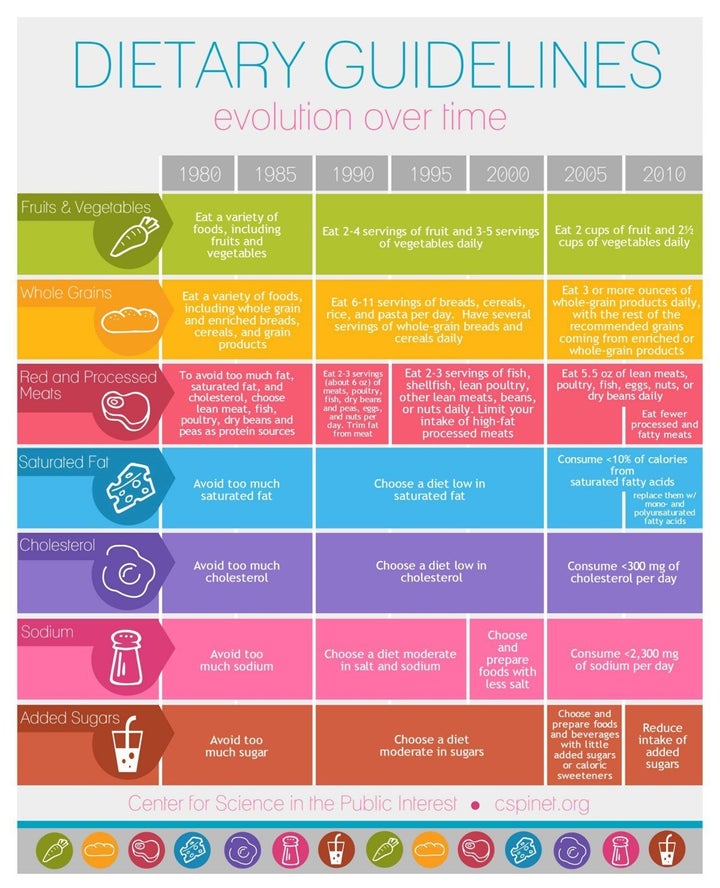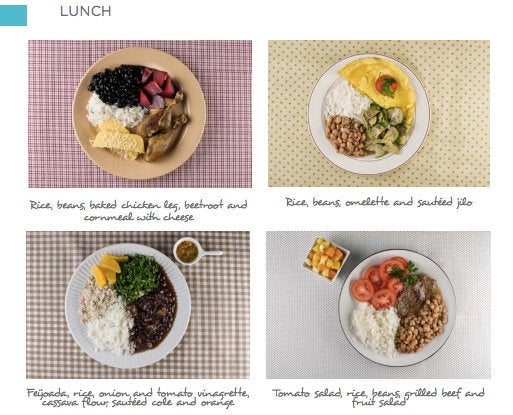
It’s been weeks since the latest federal dietary guidelines were released by the U.S. Departments of Agriculture and Health and Human Services.
Since then, a deluge of nutrition experts have expressed frustration and dismay that the guidelines didn't use stronger language when it comes to red and processed meat consumption and sustainability issues. At a time when over two-thirds of Americans are considered overweight and at increased risk of preventable, diet-related health issues, many have argued the new guidelines fail to go far enough in spelling out healthier eating patterns.
The extent to which the guidelines have actually had an influence on what Americans eat, however, is unclear. Though the guidelines have for years pushed for increased fruit and vegetable intake, the vast majority of us still aren't eating recommended amounts, according to the USDA.
So, if the guidelines aren't making us healthier, do they even matter?

They do for the millions of Americans who rely on public programs to eat. For that reason, it's crucial to continually critique the guidelines' effectiveness and carefully examine its weaknesses so they can be improved.
Here are some of the biggest issues:
The government's guidelines are vague, though nutritional advice generally isn't.
Thomas Sherman, a medical school professor and biochemist at Georgetown University, points to the guidelines' heavy influence on what foods and serving sizes are included in the national school lunch program, as well as what products can be purchased using benefits from the Women, Infants and Children and Supplemental Nutrition Assistance Programs.
Americans relying on these programs for their nutritional needs, Sherman noted, “are people who don’t have as big a voice.”
Still, he said, the government has struggled over the years to present the guidelines in a way that they are easily understandable and usable, creating a gray area filled in by an “industry of experts” who “interpret, critique, rephrase or reimagine the guidelines,” making them particularly difficult to follow in any meaningful way.
And this is despite the fact that the guidelines have not changed much since the government first began offering nutrition advice many decades ago. The heart of the message has mostly remained that we should eat fruits and vegetables, whole grains, nuts, and legumes, and limit our consumption of meat, sugar and salt intake -- though the wording has varied.
“I think the average person would have a very difficult time just making sense of it,” Sherman told The Huffington Post. “It’s difficult to go shopping with the guidelines in your hand and do meal planning.”

They don't do enough to address the food choices we are making every day.
Bonnie Liebman, director of nutrition at the Center for Science in the Public Interest, a consumer advocacy group focused on food issues, agrees with Sherman. But she doesn’t believe any confusion surrounding the guidelines should be blamed when it comes to America’s struggles with obesity and obesity-related health conditions.
Instead, she argues, we should be talking about the increases over recent decades in both the number of eating establishments and the serving sizes of the food they serve, the improved availability of unhealthy calorie-dense foods, and the impact of the food industry’s marketing.
When the government's first dietary guidelines were released in 1980, for example, McDonald's had about 5,000 U.S. locations. Today, that number hovers around 14,300. And in the time since the ubiquitous chain was founded, the Centers for Disease Control and Prevention reports the average meal served at any restaurant has grown four times larger.
“I think the guidelines matter more to nutrition experts than to the average person, I’m sorry to say,” Liebman said.
They historically haven't influenced what we eat.
It bears repeating: The guidelines’ recommendations have not had much of an effect on consumer intake of different food groups.
And then there’s what Liebman’s group and others have called “the Snackwell myth.” The federal guidelines came down hard on saturated fat in the 1990s, which spurred companies like Nabisco to come up with low-fat (but often high-sugar) products such as the Snackwell's line. As the theory goes, Americans ultimately overate such foods, causing the obesity rate to continue to grow.
But lost in discussion around the so-called Snackwell’s effect is that, according to USDA data, the average Americans’ fat intake actually increased during the 1990s.
Consider the diet advice Dr. Nick Riviera offered Homer Simpson on a 1996 episode of "The Simpsons," below. For all practical purposes, the food pyramid spoof Dr. Nick presented could have had the same impact as the guidelines' fat-free message.
“You want to focus on the neglected food groups such as the whipped group, the congealed group and the choco-tastic!” Dr. Riviera suggested.
“I think academics who give nutrition advice would like to believe their guidelines influence what people eat, but that’s ignoring the elephant in the room,” Liebman added.
It doesn't have to be this way.
Still, there’s definite room for improvement of the guidelines, particularly in how they are presented. As NPR’s Maria Godoy pointed out earlier this month, the government has been struggling to visually communicate its nutrition advice for years.
In 1980, the U.S. government's “Food Wheel” illustration made it difficult to decipher at a glance which foods to eat less or more of. It was ultimately replaced in 1992 by the food pyramid, which made it easier to tell which foods to eat more of, but may have overemphasized carbs.
As examples of the direction the U.S. should take, Sherman pointed to guidelines created by the governments of Brazil and Sweden. Both countries offer more specific instructions of which foods to embrace and which to avoid, as well as photographs of what a balanced, healthful meal looks like.
We have a long way to go.
The U.S. guidelines typically name nutrients to limit -- like saturated fats, salt and sugar -- but not the particular foods that are rich in them.

It's a huge omission, but Liebman argues the average American’s level of nutrition still comes back to the role the food industry plays in crafting marketing messages that resonate more than the government’s advice, particularly when it comes to children.
The food industry, she says, is doing the majority of the nation’s nutrition “education.”
“There are many kids in this country who think that lunch is a burger or chicken nuggets with fries and a soft drink,” Liebman said. “They didn’t learn that in school. They learn that because that’s what a ‘kids’ meal’ is.”
Joseph Erbentraut covers promising innovations and challenges in the areas of food and water. In addition, Erbentraut explores the evolving ways Americans are identifying and defining themselves. Tips? Email joseph.erbentraut@huffingtonpost.com.